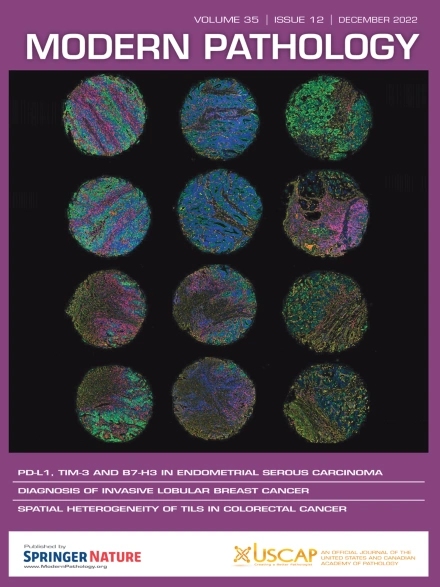Evidence for Unified Assessment Criteria of HER2 Immunohistochemistry in Colorectal Carcinoma
IF 7.1
1区 医学
Q1 PATHOLOGY
引用次数: 0
Abstract
Human epidermal growth factor receptor-2 (HER2) expression is an important biomarker for the management of RAS wild-type metastatic colorectal carcinoma (CRC). Immunohistochemistry (IHC) with reflex in situ hybridization (ISH) is accepted as a standard method of assessment, yet there are currently the following 2 sets of criteria used to interpret results: the HER2 Amplification for Colorectal Cancer Enhanced Stratification (HERACLES) criteria and the MyPathway criteria. The HER2 Amplification for Colorectal Cancer Enhanced Stratification criteria require ISH confirmation when IHC staining is 3+ in 10% to 49% of cells, whereas the MyPathway criteria mirror those for gastric HER2 assessment and do not recommend ISH confirmation in the previously referenced scenario. We aimed to assess the prevalence of HER2 3+ heterogeneity and its association with ERBB2 copy number amplification to evaluate the necessity of ISH testing when IHC staining is 3+ in <50% of cells. Next-generation sequencing of DNA (592-gene panel or whole exome sequencing) was performed for 13,208 CRC tumors submitted to Caris Life Sciences. HER2 (4B5) expression was tested using IHC. A subset of tumors was tested for ERBB2 amplification via chromogenic ISH and/or via next-generation sequencing (copy number amplification). χ2 tests or Fisher exact tests were applied where appropriate, with P values adjusted for multiple comparisons (P < .05). Of 13,208 CRCs with HER2 IHC, 87.4% (11,541/13,208) were negative for HER2 expression (≤3+ intensity and <10% tumor-cell staining) and 11.2% (1473/13,208) demonstrated at least low HER2 expression (1 to 2+ and ≥10%). Only 1.5% (194/13,208) of all tested tumors were either positive or heterogeneously positive for HER2 overexpression (3+ and ≥10%). Of these, 14% (28/194) had heterogenous HER2 overexpression (3+ staining of 10%-49% of cells). Among 22 HER2-positive/heterogenous cases with successful ISH testing, 100% (22/22) demonstrated amplification via ISH. Because the classification of tumors as HER2-positive/heterogenous using IHC correlated very closely with ISH positivity, our results suggest that ISH is likely unnecessary for CRCs with 3+ HER2 overexpression in 10% to 49% of neoplastic cells.
结直肠癌 HER2 IHC 统一评估标准的证据
HER2 表达是治疗 RAS 野生型转移性结直肠癌 (CRC) 的重要生物标志物。带有反射性原位杂交(ISH)的免疫组化(IHC)是公认的标准评估方法,但目前有两套用于解释结果的标准:HERACLES 标准和 My Pathway 标准。HERACLES 标准要求在 10-49% 的细胞中 IHC 染色为 3+ 时进行 ISH 确认,而 My Pathway 标准参照了胃癌 HER2 评估标准,不建议在前面提到的情况下进行 ISH 确认。我们的目的是评估 HER2 3+ 异质性的发生率及其与 ERBB2 拷贝数扩增(CNA)的关联性,以评估当 IHC 染色在 2/Fisher-Exact检验中出现 3+ 时进行 ISH 检验的必要性,并酌情对 p 值进行多重比较调整(p< 0.05)。在 13 208 例进行了 HER2 IHC 检测的 CRC 中,87.4%(11 541/13 208 例)的 HER2 表达为阴性(强度≤3+,肿瘤细胞染色<10%),11.2%(1 473/13 208 例)至少有较低的 HER2 表达(1-2+,≥10%)。在所有检测的肿瘤中,只有 1.5%(194/13 208)的肿瘤呈 HER2 过表达阳性或异质性阳性(3+,≥10%)。其中,14%(28/194)为异质性 HER2 过表达(10-49% 的细胞染色为 3+)。在 22 例成功通过 ISH 检测的 HER2 阳性/异源性病例中,100%(22/22)通过 ISH 显示出扩增。由于 IHC 将肿瘤分类为 HER2 阳性/异源性与 ISH 阳性密切相关,因此我们的结果表明,对于 10-49% 的肿瘤细胞中 HER2 过表达为 3+ 的 CRC,很可能不需要 ISH。
本文章由计算机程序翻译,如有差异,请以英文原文为准。
求助全文
约1分钟内获得全文
求助全文
来源期刊

Modern Pathology
医学-病理学
CiteScore
14.30
自引率
2.70%
发文量
174
审稿时长
18 days
期刊介绍:
Modern Pathology, an international journal under the ownership of The United States & Canadian Academy of Pathology (USCAP), serves as an authoritative platform for publishing top-tier clinical and translational research studies in pathology.
Original manuscripts are the primary focus of Modern Pathology, complemented by impactful editorials, reviews, and practice guidelines covering all facets of precision diagnostics in human pathology. The journal's scope includes advancements in molecular diagnostics and genomic classifications of diseases, breakthroughs in immune-oncology, computational science, applied bioinformatics, and digital pathology.
 求助内容:
求助内容: 应助结果提醒方式:
应助结果提醒方式:


